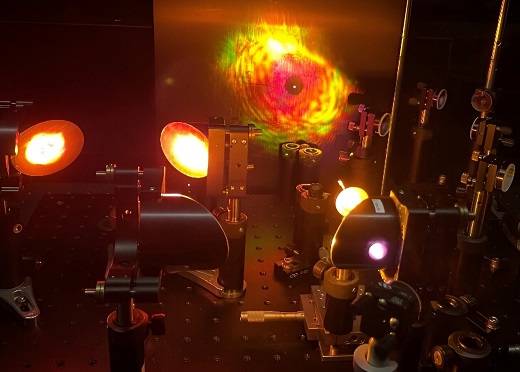by Frontiers Journals

Photo of a supercontinuum being generated by a short-pulsed laser. The creation of a plasma produces light that spans the visible and invisible parts of the electromagnetic spectrum. Credit: Frontiers of Optoelectronics (2023). DOI: 10.1007/s12200-023-00095-y
The search for and development of efficient terahertz (THz) sources is one of the major scientific goals of the 21st century. The THz region of the electromagnetic spectrum is composed of light frequencies in between the infrared and the microwave bands and accounts for one of the last scarcely explored regions of light―there are not many strong and efficient sources and detectors currently available for the THz frequency range.
Recent efforts to produce THz sources involve the use of large-scale laser facilities using ultra-short pulsed lasers capable of delivering roughly the amount of power consumed by a trillion of 1 W light bulbswithin the span of a quadrillionth of a second. The intensity at the focus of these lasers is strong enough to rip electrons out of materials (matter is turned into plasma), leading to generation of light throughout the entire electromagnetic spectrum.
Unfortunately, to produce stronger THz frequencies with this method, the current laser technology only allows for a few "shots" to be fired over the span of several minutes or hours. This means that to measure and characterize the THz sources properly, a detection method able to fully characterize the radiation produced within a single shot must be developed.
Researchers led by Prof. X.-C. Zhang at The Institute of Optics, University of Rochester in New York, U.S., have expanded upon a method to detect THz electric field by converting it to visible light known as "THz field-induced second harmonic" (TFISH) generation. This method uses nonlinear optics (the study of the interaction between matter and very intense light) to double the frequency of an optical beam in the presence of a THz wave.
While this method of measurement has been used for nearly two decades, the researchers devised a new strategy to measure the radiation directly at the plasma source as it is produced. The work, titled "Local measurement of terahertz field-induced second harmonic generation in plasma filaments," was published on December 13, 2023 in Frontiers of Optoelectronics.
Because the THz wave is confined to the plasma when it is initiated, the nonlinear conversion from THz to visible light is extremely efficient and can even be detected with an unaided eye. In their system, the researchers produce plasma in dry air with an intense beam and use a second weak laser beam of optical radiation to probe the plasma at a noncollinear angle. By timing the arrival of the probing beam to the creation of the plasma, the researchers can characterize the dynamics of the plasma, providing a full measurement suite for the THz source.
Additionally, using a grating to alter the timing across the probing beam, the researchers showcased the first measurement of a TFISH signal made within one single laser shot. This method provides the largest bandwidth for THz single-shot detection to date.

